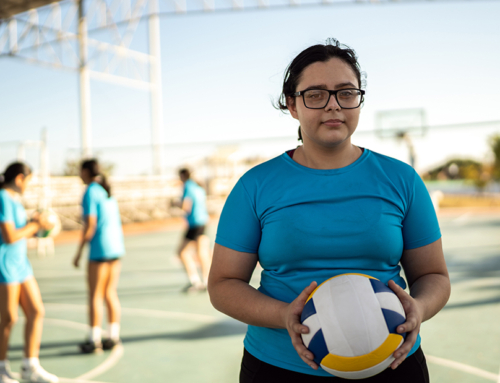Parents know that every child they bring into their family adds to their monthly food bill, and that food costs only go up as the kids grow up, get bigger and reach the age where they can play sports. For parents of multiple athletes, hefty grocery bills are a weekly occurrence.
“We easily spent $500 a week on food,” says Mindy Gallagher, a Cleveland-area mother of three boys who were all multi-sport athletes. “I would go to the grocery store almost every day.”
Money isn’t the only obstacle athlete parents face. For many, time is also a problem. They spend hours preparing meals and snacks, obviously. But Gallagher and other parents confirm that when kids play different sports with varying practice and game schedules, getting everybody together for a family meal is especially challenging.
Several moms and dads shared tips on how they kept everybody fed without losing their house in the process.
1. Cook Before You Have to Cook
Parents agree that the best way to make sure everybody has enough to eat is to be proactive and have meals ready for crunch time.
“The big go-to for me is to take some time in the morning to cook up some chicken or hamburger along with some noodles and sauce,” says Mike Connors, a father of four kids ages 9-13 who all play sports in Valley View, Ohio. “With some kids coming home from practice, and others going out to it, it’s good to have food that’s hot and available when you need it.”
Gallagher said when her three sons were in the house (her boys Jamie, Brendan and Ryan are all college athletes now), she spent part of her weekends making food that could be eaten throughout the week. “Sunday afternoons were a big cooking and baking day,” she says. “I cooked muffins, cookies, granola bars and desserts from scratch. Whatever could go in the freezer for later in the week, did.“
2. Send Your Kids Packing
The only thing more expensive than grocery shopping for active kids is buying school lunches. The fare available at many schools is pricey and often disappointing in terms of taste and nutrition (let’s not forget that thanks to government rules on school lunches, ketchup and pizza are considered vegetables). Cost-conscious (and health-conscious) parents work to pack lunches for their kids.
“I always made extra at dinner so that the girls could bring leftovers to school for lunch,” says Pam Hawkins, a Mufreesboro, Tennessee-based mother of three girls, all of whom participated in high-mileage sports (one was a cross-country runner, the other two played soccer). “A good thermos is a must. I packed small coolers with wraps (bread for sandwiches gets mushy), fresh fruit and a treat.”
3. Buy in Bulk Whenever You Can
Memberships at bulk grocery stores such as BJ’s, Costco or Sam’s Club seemed to be a must among parents of athletes.
“Sam’s Wholesale Club was my best friend,” Hawkins says. “I bought water, Gatorade and protein bars in bulk. Plus nuts, fruit and frozen vegetables and meats.”
Besides the money, parents appreciate that the big-size stores save them time by reducing the number of trips to the store. “There are 100 different ways to save money, but I just tend to lean on Sam’s Club. I feel like you just gotta put your eggs in one basket and find the deals that are there,” Connors says.
4. Prepare Calorie-Dense Foods That Keep Well
One way to make sure you always have food ready is to make meals that contain a large amount of calories (such as those with rice, pasta or potatoes), which can be plate-ready at a moment’s notice.
“I made dinners that were easily reheated: tacos, pasta and chicken casseroles,” Gallagher says. “Sometimes I was cooking dinner at 1 or 2 p.m. Fortunately, I worked from home.”
Hawkins adds that re-heatable meals were a necessity at her household during travel soccer season. She says, “I learned to rely on a rice cooker and crockpot to keep things warm. We ate lots of pasta, potatoes and rice. Cheap but filling.”
5. Power Up on Produce
Young, growing athletes often want to build muscle. To many, muscle means “eat protein,” and “protein” is synonymous with “meat.” But eating fruits and vegetables—which also provide beneficial vitamins and minerals—is arguably even more important. One way to satisfy both needs is to cook with beans, which are a cost-effective food that delivers both protein and nutrients. Buying frozen fruits and vegetables is another way to get produce without the risk of spoilage.
6. Help Your Kids Be Smart About Snack Attacks
For a student-athlete, a typical school day starts between 7:00 and 8:00 a.m., lasts until after 2:00 p.m., and keeps going until practice wraps up some time after 5:00 p.m. That’s a long span to cover with just a single meal (lunch), especially for active individuals who burn more calories faster. “I tried to pack snacks,” Hawkins says. “I’d often include Rice Krispie Treats or something they could eat before practice or a game.”
Rice Krispie Treats may not sound like optimum nutrition, but for an athlete who’s about to be active, they’re a far better snack choice than many other foods most people consider “healthy.” The consensus is that sugar is bad and fiber is good. And that’s usually true—unless you’re about to start running around a football field or soccer pitch. Then items high in fiber are not your friend, because they take longer to digest. Hawkins found this out the hard way when she packed a cut-up pineapple, which contains roughly half of a person’s daily value in fiber, as a snack for her daughter.
“She ate the whole thing on the bus,” Hawkins remembers. “She didn’t appreciate the nickname ‘Pineapple Express’ she earned after she got sick during halftime.”
7. Have a Plan B
No matter how well you plan, there will be times when you have to deal with the unexpected. When that happens, it’s good to have a fallback plan in place. “I kept individually wrapped frozen fish and chicken in the freezer so when we came home from a meet or a game, I could defrost, throw on the grill, and make with rice and a vegetable for dinner,” says Hawkins.
8. Sit Together, Even if it’s Late
It’s impossible to put a price on family time. Unfortunately, when athlete schedules conflict, it’s nearly impossible to get everyone in the same place for an hour. Connors says his family tries to make sure they have at least one sit-down meal together each week. “Meal time is so important,” he says. “Sitting down with your family and talking to your kids, so it’s not just about rushing around and juggling schedules. You gotta have those activities, but at the same time it’s good to pick a day to sit down and just have a conversation over a bowl of spaghetti or whatever.”
Gallagher says eating meals together helped her family bond—and save money. “Eating as a family avoided us having to have five different meals and wasting food,” Gallagher says. “It was definitely more work to cook every night, but worth it on the health and budget fronts. And if one of the kids had a late practice or game, either my husband or I would sit with them while they ate dinner.”
Original article posted on stack.com
RELATED



